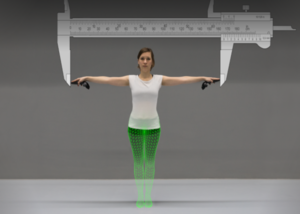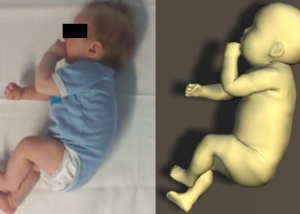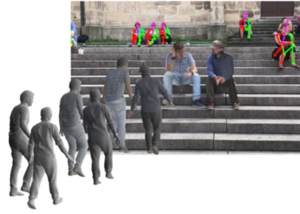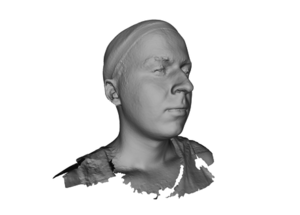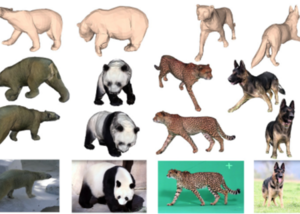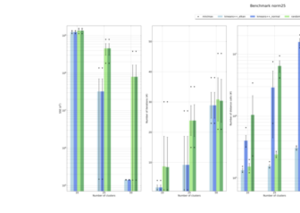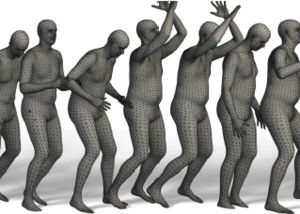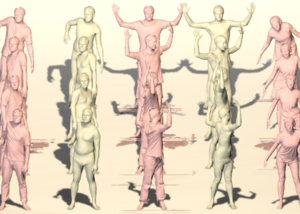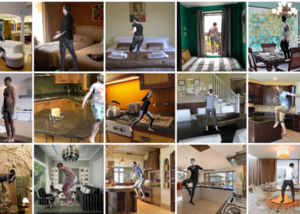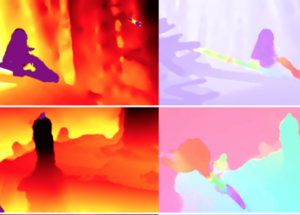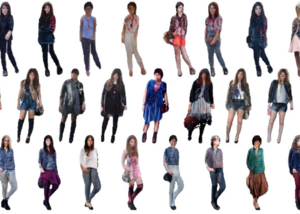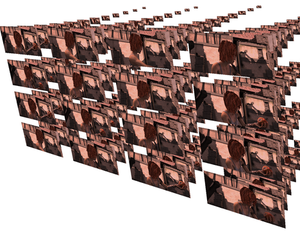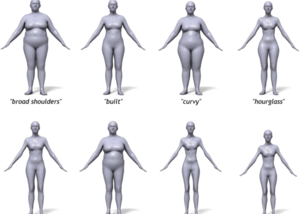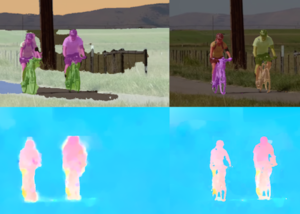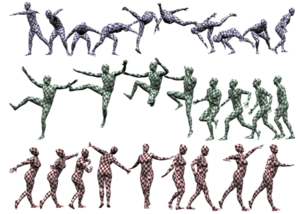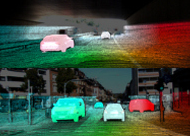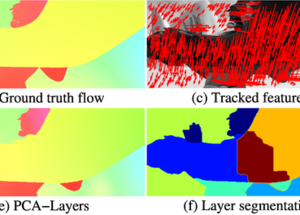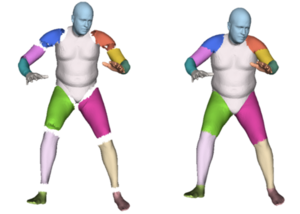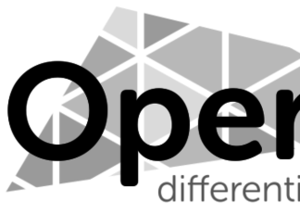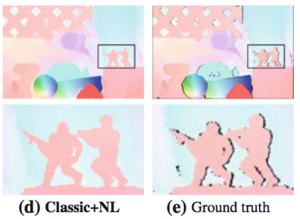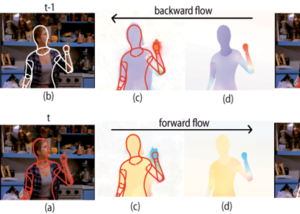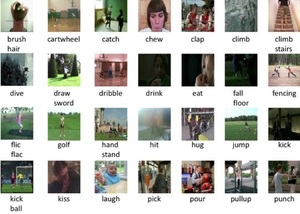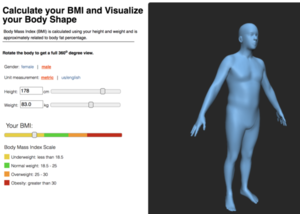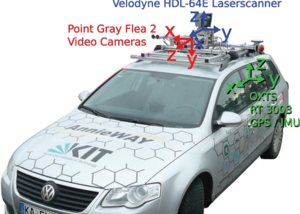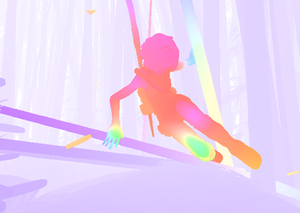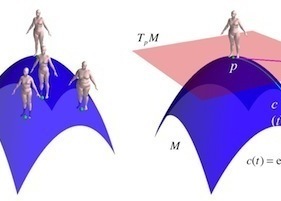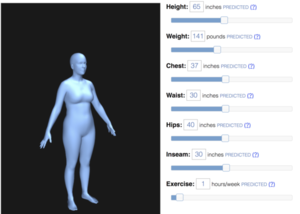Code & Data
Filter by
LICENSE TYPE
Perceiving Systems
PS:License 1.0
Learning joint reconstruction of hands and manipulated objects
Estimating hand-object manipulation is essential for interpreting and imitating human actions. Previous work has made significant progress towards reconstruction of hand poses and object shapes in isolation. Yet, reconstructing hands and objects during manipulation is a more challenging task due to significant occlusions of both the hand and object. While presenting challenges, manipulations may also simplify the problem since the physics of contact restricts the space of valid hand-object configurations. For example, during manipulation, the hand and object should be in contact but not int...
Perceiving Systems
The MIT License
RingNet: Learning to Regress 3D Face Shape and Expression from an Image without 3D Supervision
Code: We provide the inference code of RingNet. Please check the repository which is self explanatory.
NoW Benchmark Dataset and Challenge: Please check the external link to download the data and participate in the challenge.
Perceiving Systems
The MIT License
VOCA: Capture, Learning, and Synthesis of 3D Speaking Styles
VOCA (Voice Operated Character Animation) is a framework that takes a speech signal as input and realistically animates a wide range of adult faces.
<p><strong>Code: </strong>We provide Python demo code that outputs a 3D head animation given a speech signal and a static 3D head mesh. The codebase further provides animation control to alter the speaking style, identity-dependent facial shape, and head pose (i.e. head rotation around the neck) during animation. The code further demonstrates how to sample 3D head meshes from the publicly available FLAME model, that can then be animated&nbs...
Perceiving Systems
PS:License 1.0
The Virtual Caliper: Rapid Creation of Metrically Accurate Avatars from 3D Measurements
The Virtual Caliper project provides you with software tools to rapidly generate metrically accurate avatars based on measurements. These avatars can be generated offline in FBX format for later import into game engines or alternatively within the game engine itself. Avatars are based on the SMPL body model and support skeletal mesh animation.
Released software includes Unity project files and standalone binaries for Windows/Linux/macOS and Blender Python code for FBX generation.
Software Workshop
Perceiving Systems
PS:License 1.0
Monocle
Application used for capturing from the Kinect 2.0 device.
Perceiving Systems
PS:License 1.0
Deep Inertial Poser: Learning to Reconstruct Human Pose from Sparse Inertial Measurements in Real Time
This is the code for our SIGGRAPH Asia 2018 project <Deep Inertial Poser: Learning to Reconstruct Human Pose from Sparse Inertial Measurements in Real Time>. The BiRNN model training and testing parts along with real-time demo are released to facilitate reproductivity and future research. The large-scale synthetic dataset and real DIP-IMU we introduced in the paper are compatible with this code, and can be accessed via the project page.
Perceiving Systems
PS:License 1.0
Skinned Multi-Infant Linear Model (SMIL)
SMIL is a learned 3D model of infant body shape and pose that can be animated and fit to data. It is based on SMPL but the shape space is adapted to capture the body shape of babies.
Perceiving Systems
PS:License 1.0
3D Poses in the Wild Dataset
The "3D Poses in the Wild dataset" is the first dataset with monocular hand-held video together with accurate 3D human poses for evaluation. Our method combines video and IMU to recover accurate 3D human body models and their projection into the video sequences. The dataset includes: 60 video sequences; 2D pose annotations; 3D poses obtained with our method; Camera poses for every frame in the sequences; 3D body scans; and 18 3D human models with different clothing variations.
Perceiving Systems
The MIT License
Convolutional Mesh Autoencoders
The code allows to build convolutional networks on mesh structures analogous to CNNs on images. The code includes mesh convolutions, and introduces downsampling and upsampling operators that can be directly applied to the mesh structure. The code implements a Convolution Mesh Autoencoder using the above mesh processing operators and achieves state of the art results on generating 3D facial meshes.
Perceiving Systems
Software Workshop
PS:License 1.0
Mesh Library
When working in 3D graphics, one needs to load raw data, conduct various processing on it, visualize the results to help understanding, then save the output in different kinds of formats. Here we release the Mesh Library to facilitate all these aforementioned operations. This library is built on top of OpenGL and CGAL, with an easy-to-use Python interface. Other than the basic usages like data IO and interactive visualization, it also supports other more complex functionalities like texture rendering, visibility computation, and geometry arithmetic. We hope the release of this tool makes th...
Perceiving Systems
The MIT License
Learning Human Optical Flow
The optical flow of humans is well known to be useful for the analysis of human action. Given this, we devise an optical flow algorithm specifically for human motion and show that it is superior to generic flow methods. Designing a method by hand is impractical, so we develop a new training database of image sequences with ground truth optical flow. For this we use a 3D model of the human body and motion capture data to synthesize realistic flow fields. We then train a convolutional neural network to estimate human flow fields from pairs of images. Since many applications in human motion an...
Perceiving Systems
PS:License 1.0
SMALR: Capturing Animal Shape and Texture from Images
The SMALR release includes an updated SMAL model of animals and 3D animal models recovered from images. SMALR is the Skinned Multi-Animal Linear Model with Refinement. All the 3D shapes from the CVPR paper are available for download as 3D meshes, which can be posed and animated. As we create new meshes, they will be added here.
Software Workshop
Perceiving Systems
PS:License 1.0
Accelerated K-means
An efficient and generic implementation of the k-means clustering algoriothm.
Perceiving Systems
PS:License 1.0
HMR: End-to-end Recovery of Human Shape and Pose
Trained model to estimate 3D human shape and pose directly from an image. The input is pixels, and the output is a 3D body in SMPL format (shape parameters and pose parameters). Also provided is the code and data needed to train the model.
Perceiving Systems
Apache License, Version 2.0
Towards Accurate Marker-less Human Shape and Pose Estimation over Time
Model-based reconstruction of 3D SMPL body shape and pose from multi-view images. 2D joints and silhouettes from multi-view are used in the process. And DCT-based temporal prior is utilized to regularize the recovered 3D joint trajectory.
Perceiving Systems
PS:License 1.0
FLAME: 3D model of facial shape and expression
FLAME is a lightweight and expressive generic head model learned from over 33,000 of accurately aligned 3D scans.
We provide the trained 3D face models, registrations for the dynamic D3DFACS dataset, and demo code in Chumpy and Tensorflow to load and sample the model, and to fit the model to 3D landmarks.
Perceiving Systems
PS:License 1.0
MANO: 3D hand model
Data, code and model. This includes over 1000 3D hand scans and aligned meshes, the learned 3D hand shape model, the full articulated hand model with pose-dependent blend shapes. Also included is the SMPL body model with the hands attached to it, providing a realistic hand and body model.
Perceiving Systems
PS:License 1.0
BUFF: Bodies under Flowing Fashion, 4D dataset
High quality 4D dataset of people in clothing with ground truth 3D shape. The BUFF dataset consists of 5 subjects, 3 male and 2 female wearing 2 clothing styles: a) t-shirt and long pants and b) a soccer outfit. They perform 3 different motions i) hips ii) tilt_twist_left iii) shoulders_mill.
Perceiving Systems
PS:License 1.0
Dynamic FAUST
This dataset is a unique resource containing over 40,000 4D scans of multiple people; 4D means 3D scans over time. Processing 4D data is challenging, so we provide aligned data in which we have registered a common template mesh to all scans. This alignment process takes into account geometry and surface texture to make it accurate. The dataset includes the raw scan data, registered template meshes, and masks that say where the template mesh is sufficiently accurate to be considered ground truth.
Perceiving Systems
PS:License 1.0
SMAL: 3D articulated model of animals shapes
We provide the SMAL model of animal shapes and demo code. We also provide all the results from the CVPR paper of animal shapes estimated from images. We do not provide the 3D scans of the toy animals for copyright reasons but do provide a shopping list so that you can purchase the same toys that we used.
Perceiving Systems
PS:License 1.0
SURREAL: Synthetic human dataset and trained networks
First large-scale person dataset to generate depth, body parts, optical flow, 2D/3D pose, surface normals ground truth for RGB video input. The dataset contains 6M frames of synthetic humans. The images are photo-realistic renderings of people under large variations in shape, texture, view-point and pose. To ensure realism, the synthetic bodies are created using the SMPL body model, whose parameters are fit by the MoSh method given raw 3D MoCap marker data. Trained CNNs are also provided.
Perceiving Systems
PS:License 1.0
Unite the People – Closing the Loop Between 3D and 2D Human Representations
The dataset includes annotations of common human pose datasets. These include 3D body pose, 91 surface and joint landmarks, foreground segmentation, and body part segments. Together with the images, these can be used to train neural networks for human pose estimation tasks, including 3D pose estimation. The 3D body is represented by SMPL. Training code is provided.
Perceiving Systems
PS:License 1.0
MR-Flow: Optical flow in mostly-rigid scenes
Code for the paper "Optical Flow in Mostly Rigid Scenes" by Jonas Wulff, Laura Sevilla-Lara, Michael Black, CVPR 2017. This is one of the best performing methods across different datasets. In rigid parts of the scene, a plane-plus-parallax model is used. The method segments out the non-rigid regions and uses a more generic flow method there.
Perceiving Systems
PS:License 1.0
A Generative Model of People in Clothing
We provide an image-based generative model of people in clothing for the full body. The training dataset is built on top of Chictopia10K. We provide processed annotations as well as the SMPL body model fit to the images. We also provide our trained models for download.
Perceiving Systems
Autonomous Vision
PS:License 1.0
Slow Flow: Exploiting High-Speed Cameras for Accurate and Diverse Optical Flow Reference Data
Existing optical flow datasets are limited in size and variability due to the difficulty of capturing dense ground truth. In this paper, we tackle this problem by tracking pixels through densely sampled space-time volumes recorded with a high-speed video camera. Our model exploits the linearity of small motions and reasons about occlusions from multiple frames. Using our technique, we are able to establish accurate reference flow fields outside the laboratory in natural environments. Besides, we show how our predictions can be used to augment the input images with realistic motion blur. We ...
Software Workshop
Perceiving Systems
PS:License 1.0
Scan Manager
A web application for being able to manage the increasing amount of body scans.
Perceiving Systems
PS:License 1.0
SPyNet: Optical Flow Estimation using a Spatial Pyramid Network
We learn to compute optical flow by combining a classical spatial-pyramid formulation with deep learning. This estimates large motions in a coarse-to-fine approach by warping one image of a pair at each pyramid level by the current flow estimate and computing an update to the flow. Instead of the standard minimization of an objective function at each pyramid level, we train one deep network per level to compute the flow update. Check the website for updates; we provide code for the original SypNet as well as an end-to-end trainable version.
Perceiving Systems
PS:License 1.0
Capturing Hand-Object Interaction and Reconstruction of Manipulated Objects
Webpages for the GCPR 2013, GCPR 2014, ICCV 2015, IJCV 2016, ECCVw 2016 papers. The data contains: (IJCV 2016, GCPR 2014) annotated RGB-D and multicamera-RGB dataset of one or two hands interacting with each other and/or with a rigid or an articulated object, (ICCV 2015) RGB-D dataset of a hand rotating a rigid object for 3d scanning, (GCPR 2013) synthetic dataset of two hands interacting with each other, (ECCVw 2016) RGB-D dataset of an object under manipulation.
Perceiving Systems
PS:License 1.0
SMPLify: 3D human pose and shape estimation from a single image
Given a single image, extract the 3D SMPL pose and shape parameters. We provide a Python demo code needed to run SMPLify. We also provide results from the ECCV paper for comparison. For all the datasets we used (LSP, HumanEva-I, Human3.6M) we provide the detected joints and our results as SMPL model parameters and as a mesh (vertices and faces). The code package includes an example script showing how to load results. Please see the README in the code package and the FAQ.
Perceiving Systems
PS:License 1.0
BodyTalk: Tool that relates 3D body shape to words
This website provides a tool to explore 3D body shape and linguistic descriptions of shape. We provide a set of shape sliders and linguistic sliders that can be used to change body shape. This allows you to explore how people think about body shape and how shape and adjectives are correlated.
Perceiving Systems
PS:License 1.0
Semantic Optical Flow
Data and code necessary to reproduce results from the CVPR 2016 paper on semantic optical flow. Semantic scene segmentation enables different flow models to be used in different regions and then composed using a locally layered approach.
Perceiving Systems
PS:License 1.0
Video segmentation via object flow
Matlab implementation of the paper
Video Segmentation via Object Flow
Yi-Hsuan Tsai, Ming-Hsuan Yang and Michael J. Black
IEEE Conference on Computer Vision and Pattern Recognition (CVPR), 2016.
Perceiving Systems
PS:License 1.0
SMPL: A skinned multi-person linear body model
SMPL is like a PDF format for 3D bodies. It is a realistic 3D model of the human body that is based on blend skinning and blend shapes that is learned from thousands of 3D body scans. It is fully portable, works with many existing game engines and is useful for computer vision.
This site provides resources to learn about SMPL, including example FBX files with animated SMPL models, and code for using SMPL in Python, Maya and Unity.
The Python code shows how to use SMPL in computer vision problems. Maya and Unity scripts help set up the model for animation in these 3D environments.
We p...
Perceiving Systems
PS:License 1.0
MoSh: Motion and Shape Capture from Sparse Markers
The original MoSh dataset is available as well as code for the latest MoSh++ method. Marker-based motion capture (mocap) is widely criticized as producing lifeless animations. MoSh (Motion and Shape capture), automatically extracts detail present in the original mocap maker data. MoSh estimates body shape and pose together using sparse marker data by exploiting a parametric model of the human body. The dataset contains: 1) The original .c3d files with MOCAP marker-data. 2) Estimated 3D shape meshes. 3) 3D scans from a high resolution scanner for comparison. The code is the latest MoSh++ m...
Perceiving Systems
PS:License 1.0
Dyna: 4D meshes of dynamic human soft tissue motion
To look human, digital full-body avatars need to have soft tissue deformations like those of real people. Current methods for physics simulation of soft tissue lack realism, are computationally expensive, or are hard to tune. Learning soft tissue motion from example, however, has been limited by the lack of dense, high-resolution, training data. We address this using a 4D capture system and a method for accurately registering 3D scans across time to a template mesh. Using over 40,000 scans of ten subjects, we compute how soft tissue motion causes mesh triangles to deform relative to a base ...
Perceiving Systems
PS:License 1.0
Pose-Conditioned Joint Angle Limits for 3D Human Pose Reconstruction (code and data)
This release contains code and data. Most mocap datasets are too small or to constrained to capture the full range of human motions. In particular, they are too small to explore joint angle limits. Here we provide a mocap dataset in which the subjects are gymnasts who are able to explore a wide range of human poses. The dataset allows one to develop pose priors that obey these limits and to model how these joint limits actually vary with pose. We include code to learn joint angle limits and to estimate 3D pose from 2D joint locations.
Perceiving Systems
Autonomous Vision
PS:License 1.0
KITTI 2015: Stereo, Flow, and Scene Flow Benchmark
KITTI is one of the most popular datasets for evaluation of vision algorithms, particuarly in the context of street scenes and autonomous driving. The stereo 2015 / flow 2015 / scene flow 2015 benchmark consists of 200 training scenes and 200 test scenes (4 color images per scene, saved in loss less png format). Compared to the stereo 2012 and flow 2012 benchmarks, it comprises dynamic scenes for which the ground truth has been established in a semi-automatic process.
Perceiving Systems
PS:License 1.0
PCA-Flow: Fast, approximate optical flow computation
This software package contains two algorithms for the computation of optical flow, as described in Wulff & Black, "Efficient Sparse-to-Dense Optical Flow Estimation using a Learned Basis and Layers" (CVPR 2015).
PCA-Flow computes approximate optical flow extremely quickly, by making the assumption that optical flow lies on a low-dimensional subspace.
PCA-Layers extends this to a layered model to increase accuracy, especially at boundaries. It is the most accurate layered model on the MPI Sintel dataset.
Perceiving Systems
PS:License 1.0
The Stitched Puppet: A Graphical Model of 3D Human Shape and Pose
The Stitched Puppet (SP) is a realistic part-based 3D body model of the human body. It offers the best features of part-based body models used in Computer Vision and statistical body models used in Computer Graphics. The release includes data and code to fit the SP model to 3D scans.
Perceiving Systems
PS:License 1.0
OpenDR: An open differentiable renderer
The OpenDR, is the first open source differentiable renderer. It provides a simple Python interface for defining an objective function with a forward generative process and then automatically differentiating and optimizing this. OpenDR allows for quick design and testing of generative models in computer vision. The code provides examples. OpenDR has been widely use.
Perceiving Systems
PS:License 1.0
FAUST dataset: High-resolution 3D scans with ground truth correspondence
FAUST contains 300 real, high-resolution human scans of 10 different subjects in 30 different poses, with automatically computed ground-truth correspondences. We provide a training set with scans and ground truth correspondence. We also provide a separate test set of scans with an evaluation website that compares results of mesh correspondence.
Perceiving Systems
Software Workshop
The 3-Clause BSD License
Robust and scalable PCA using Grassmann averages
The Grassmann Averages PCA is a method for extracting the principal components from a sets of vectors, with the nice following properties: 1) it is of linear complexity wrt. the dimension of the vectors and the size of the data, which makes the method highly scalable, 2) It is more robust to outliers than PCA in the sense that it minimizes an L1 norm instead of the L2 norm of the standard PCA.
It comes with two variants: 1) the standard computation, that coincides with the PCA for normally distributed data, also referred to as the GA, 2) a trimmed variant, that is more robust to outliers...
Perceiving Systems
PS:License 1.0
Secrets of Optical Flow: Code for various methods
Matlab code for robust optical flow -- Classic++ and Classic-NL -- as described in the IJCV paper "A Quantitative Analysis of Current Practices in Optical Flow Estimation and the Principles behind Them". This code is widely used as a baseline and starting point for "classical" flow methods.
Matlab version of the "Black and Anandan" robust flow method: https://deqings.github.io/public_files/ba.zip
Matlab version of "Horn and Schunck": https://deqings.github.io/public_files/hs.zip
Original implementation from CVPR'2010 paper: https://deqings.github.io/public_files/cvpr10_flow_code.zip
Perceiving Systems
PS:License 1.0
Flowing Puppets
Code for ICCV'13 paper on "Estimating Human Pose with Flowing Puppets". This addresses the problem of upper-body human pose estimation in uncontrolled monocular video sequences, without manual initialization. The "flowing puppets" model provide integrates image evidence across frames to improve pose inference. We provide the code used for the experiments in the paper.
We also provide the "puppet flow" annotation tool.
Perceiving Systems
PS:License 1.0
JHMDB: Joint-annotated Human Motion Data Base
A fully annotated data set for human actions and human poses. It is based on the HMDB human motion dataset but includes optical flow on the person, the segmentation of the person, joint locations, action labels, and meta data.
Perceiving Systems
PS:License 1.0
BMI Visualizer
This website helps people understand body mass index through a novel visualization of 3D body shape. Enter height and weight to see a 3D body shape with these properties and see the corresponding BMI. Move a slider to change BMI and see how body shape changes.
Perceiving Systems
Autonomous Vision
PS:License 1.0
The KITTI Dataset
The KITTI dataset is the de-facto standard for developing and testing computer vision algorithms for real-world autonomous driving scenarios and more.
Perceiving Systems
PS:License 1.0
Sintel Optical Flow Dataset and Benchmark
The MPI Sintel Dataset is one of the most widely used datasets for training and evaluating optical flow algorithms. It is the first synthetic dataset to achieve wide use because of it well represents natural scenes and motions. It is also extremely challenging and current methods have still not fully "solved" the problem of flow estimation for Sintel. Sintel is designed to encourage research on long-range motion, motion blur, multi-frame analysis, non-rigid motion. Algorithms are evaluated on held-out test data and results are displayed for comparison.
The dataset contains flow field...
Perceiving Systems
PS:License 1.0
Lie Bodies
This code supports the core representation needed for Lie Bodies as described in Freifeld and Black, ECCV 2012. Currently this is only a partial version of what is presented in the paper. The code takes pairs of triangles and computes the "Q" matrices and the corresponding (R,A,S) decompositions that are the foundation of Lie Bodies (see paper for details).
Perceiving Systems
PS:License 1.0
Body Shape Visualizer
This web-based tool lets users enter information about body measurements (height, waist, inseam, etc) and visualize a 3D body shape that corresponds to these measurements.



